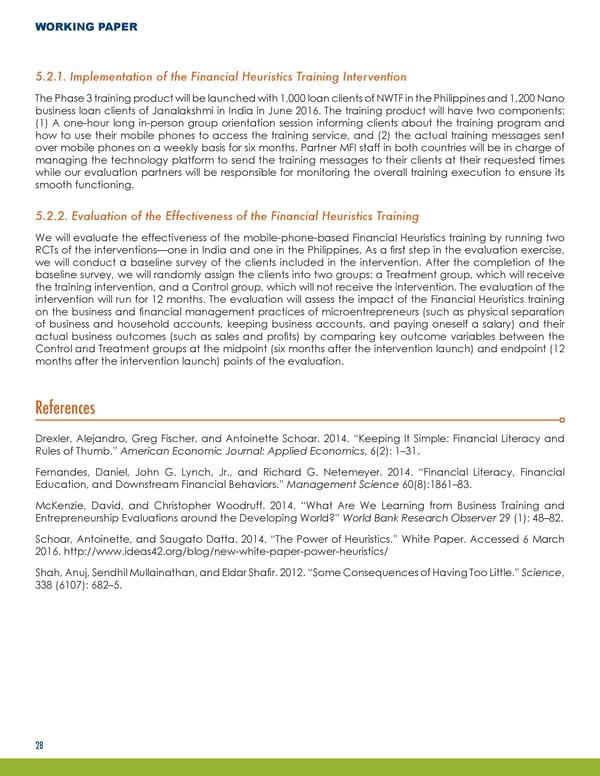WORKING PAPER 5.2.1. Implementation of the Financial Heuristics Training Intervention The Phase 3 training product will be launched with 1,000 loan clients of NWTF in the Philippines and 1,200 Nano business loan clients of Janalakshmi in India in June 2016. The training product will have two components: (1) A one-hour long in-person group orientation session informing clients about the training program and how to use their mobile phones to access the training service, and (2) the actual training messages sent over mobile phones on a weekly basis for six months. Partner MFI staff in both countries will be in charge of managing the technology platform to send the training messages to their clients at their requested times while our evaluation partners will be responsible for monitoring the overall training execution to ensure its smooth functioning. 5.2.2. Evaluation of the Effectiveness of the Financial Heuristics Training We will evaluate the effectiveness of the mobile-phone-based Financial Heuristics training by running two RCTs of the interventions—one in India and one in the Philippines. As a first step in the evaluation exercise, we will conduct a baseline survey of the clients included in the intervention. After the completion of the baseline survey, we will randomly assign the clients into two groups: a Treatment group, which will receive the training intervention, and a Control group, which will not receive the intervention. The evaluation of the intervention will run for 12 months. The evaluation will assess the impact of the Financial Heuristics training on the business and financial management practices of microentrepreneurs (such as physical separation of business and household accounts, keeping business accounts, and paying oneself a salary) and their actual business outcomes (such as sales and profits) by comparing key outcome variables between the Control and Treatment groups at the midpoint (six months after the intervention launch) and endpoint (12 months after the intervention launch) points of the evaluation. References Drexler, Alejandro, Greg Fischer, and Antoinette Schoar. 2014. “Keeping It Simple: Financial Literacy and Rules of Thumb.” American Economic Journal: Applied Economics, 6(2): 1–31. Fernandes, Daniel, John G. Lynch, Jr., and Richard G. Netemeyer. 2014. “Financial Literacy, Financial Education, and Downstream Financial Behaviors.” Management Science 60(8):1861–83. McKenzie, David, and Christopher Woodruff. 2014. “What Are We Learning from Business Training and Entrepreneurship Evaluations around the Developing World?” World Bank Research Observer 29 (1): 48–82. Schoar, Antoinette, and Saugato Datta. 2014. “The Power of Heuristics.” White Paper. Accessed 6 March 2016. http://www.ideas42.org/blog/new-white-paper-power-heuristics/ Shah, Anuj, Sendhil Mullainathan, and Eldar Shafir. 2012. “Some Consequences of Having Too Little.” Science, 338 (6107): 682–5. 28
 Using Behavioral Science to Design a Customer-Centric Financial Management Training for Microentrepreneurs Page 30 Page 32
Using Behavioral Science to Design a Customer-Centric Financial Management Training for Microentrepreneurs Page 30 Page 32